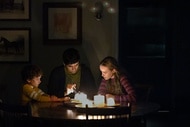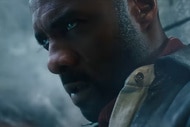Create a free profile to get unlimited access to exclusive videos, sweepstakes, and more!
Book vs. Flick: The Stand

The Stand is well remembered as being one of the first major successes of Stephen King’s career as a novelist, helping to cement his place as a hugely important up-and-coming genre writer. Of course, we all know how that worked out — he became perhaps the best-known storyteller of the 20th century. In this apocalyptic story from the late ‘70s, King quite literally walks us through a plague while also introducing us to his mythical “tall shadowy man,” who would go on to make appearances in many of his other stories, most notably The Dark Tower. In 1994, a miniseries version of the story was released via ABC, also scripted by King.
But does The Stand hold up, and how well did a network miniseries convey the abject horror of the novel? Well, with a cast of promising names and an underlying plot with infinite potential, how could it go wrong? Ha. Ha ha.
Trigger Warning: There is much graphic violence in this book, as well as some troubling tropes at play.
The novel is based around themes King first introduced in his short story "Night Surf," originally published in 1969; it was later revised and re-released in 1978 as part of the Night Shift collection. This short story gives the basis for The Stand, even providing the name of the virus that would later wreak havoc in the pages of the novel, Captain Trips. There is a film version of "Night Surf" as well, a short from 2001 that was optioned to director Peter Sullivan for $1 as part of King’s "Dollar Baby" incentive for beginning film and theater productions. Though it is much smaller in scope, "Night Surf" is a concise, slightly less biblical version of what would later bloom into The Stand.
This was King’s fourth book published under the name Stephen King, rather than his occasionally used pen name Richard Bachman. He'd proven himself capable of great things with books like Carrie and The Shining, but even so, the original version of The Stand was edited and shortened by around 150,000 words to reduce printing costs. This was all before King was a massive international success who was allowed to do whatever the heck he wanted in a book, so he had to deal with things like editors cutting hundreds of pages of filler. The unabridged version of The Stand was finally published in 1990, and it is the one that has remained in print since. It’s hard to believe that there were too many people who were sad that this book was a bit shorter for a few years, but we’ll leave it to you to decide which version you prefer. For the purposes of this review, we’re looking at the complete, unabridged version, though the differences within the plot are fairly negligible either way.
After a strange introduction delving into the creation of the virus that serves as the catalyst for the societal collapse of the novel, the audience gets the literary equivalent of a panoramic view to show us how it spreads. This strain of influenza was genetically modified for biological warfare, and it escapes its containment at an isolated base. As the complex attempts a full lockdown and quarantine and many people die, a guard manages to escape with his wife and child. Unfortunately, they are all infected, making them the “patient zero” of the illness that is eventually referred to as Captain Trips. After attempting to flee, the small family finally collapses dead at a gas station while fueling up.
After this, we shift views over several different characters to understand the devastating effect of a virus that would ultimately wipe out 99.4% of the world population. This would leave something like 85,000 people alive on Earth (if we’re reading the census of the time the book was originally published and doing our clever combination of math, estimation, and speculation correctly). This is obviously not ideal, but even worse, the people who remain are haunted by the traumatic experience of having watched everyone they ever loved die an excruciating death. Even the book's point-of-view character, Stu Redman, experiences incredible pain as he is experimented on by doctors who die off while they're torturing him, desperately trying to cure themselves via his immunity to the strain.It’s difficult to fully get into all the individual characters, because there are many, but it can’t be emphasized enough that the cast is the driving force behind what would otherwise be a fairly basic religious morality tale. The plot is straightforward, but the way all these very hurt people interact with each other and the weight of their decisions feels very real, even when it’s incredibly unpleasant. King has admitted to wishing to create a Lord of the Rings vibe with his worldbuilding and various quests, and it definitely shows. Still, there are times this all just goes completely off the rails — like, for instance, in scenes such as the one where we take on the anthropomorphized viewpoint of a dog, or when an elderly woman is forced to fight off weasels.
The survivors begin to feel drawn to either Las Vegas or Boulder, compelled by visions of a kindly elderly Black woman named Mother Abigail, contrasted with nightmares of a demonic man named Randall Flagg. The groups draw together and prepare for a final battle. The people in Boulder become overall more religious and place their trust in God. A seemingly minor, definitely disturbingly written character called the Trashcan Man randomly carts a nuclear warhead into Vegas, and Flagg unintentionally detonates the bomb. It’s fairly anticlimactic, unfortunately, but that’s not really the point of the book. The triumph of the text is in its descriptions of the rapid dissolve of society over its first half and the building tension that follows.
As for the movie, the dystopian aspects are significantly reduced considering the fact it aired on network television. One of the more intriguing aspects of the novel is that each of the characters experiences their own individual nightmares before joining together to try and rebuild. Given the vagueness of the concept, King was able to take a blank slate and run wild with it, combining a sort of grab bag of worst-case scenarios and sci-fi tropes in a way that is really engaging. The movie can only hope to echo this dynamic, but it does its best.
Also, Stephen King is actually in the film. He ... dies pretty fast.
Still, the miniseries has a fantastic cast that in the end doesn’t get to do as much as we’d like. This is definitely a situation where we see a lot of the actors severely underused, and the limitations of King as a screenwriter become more apparent. From Molly Ringwald to Gary Sinise to Kathy Bates, this cast is about as ideal as you could get for a made-for-TV movie in 1994. The series does a good job of conveying the mass destruction caused by the virus without having much of a budget for special effects and without showing the graphic violence and social decay described in the book. However, long moments that, in the novel, were filled by detailed descriptions of each character’s inner worlds are reduced to being simply empty space. In the end, a fresh screenwriter might have been able to make creative changes that would have improved the film.There have been talks since 2011 for a new take on the novel, and in that time there was a comic book adaptation of the story that ran 31 issues. A new, 10-episode miniseries is slated to appear soon, though given the starts and stops so far it may take longer than we think. At any rate, the timing would be good for a modernized take on the story that excludes some of the more problematic aspects of the book.
It would be impossible to deny the homophobia, misogyny, ableism, and racism of the many tropes of King’s early works in general, but specifically in The Stand, in which people being openly cruel and verbally and physically abusive features so prominently. There are a lot of cringe-inducing slurs that pop up in both book and film again and again. There are the introduction and the relatively quick disappearance of exaggerated Black militants that seem to represent Charles Manson’s paranoid Helter Skelter delusions of a violent racial uprising a lot more closely than they do the political writings and movements of Black activists of any era. Even worse, the book closes on Flagg waking up on the beach and being worshipped as a God by Indigenous people, and the descriptions of said people haven't aged well, to say the least.
Female characters in King books of this time are given notoriously little to do, and despite the catastrophic circumstances in which they live, the women in this story are mostly limited to their childrearing capabilities. Meanwhile, a completely unnecessary character who exemplifies what we now refer to as incel or MRA ideology is given a great deal of page space for his inner monologues about how he feels about women, and it does not make for a breezy read. More than one graphic rape occurs. Queer people appear as either victims or sadistic murderers, and homophobic slurs abound. The one Black woman at the heart of the narrative, though portrayed as saintlike, exists primarily just to help the white people sort their stuff out. The ableism is perhaps the most prominent of all the missteps, as it is linked to the plot in ways that would be difficult to detach or remove from the central philosophy.
In the end, there is no denying that entire swaths of King’s work are based in mean-spirited descriptives and glorification of a white, heterosexual, and masculine ideal. By all appearances, King has done a lot of work on himself since this book, but that doesn’t change the text at hand. There’s not much we can really add to all this, just that there are a lot of people who are going to want to skip The Stand for entirely valid reasons, and that’s OK.
The Christianity that defines the morality of the book is obvious, as the parables between this story and the legends of God and the Devil are beyond blatant by the final third of the book. It’s to everyone’s individual beliefs whether this is going to be a dealbreaker or a dealmaker, but it is definitely prominent, and seemingly derailing segments rooted in Christian beliefs abound until you begin to realize that is actually the point of the book. It becomes a bit of a Noah’s Ark scenario at that point, which drains quite a bit of the mortal terror of the first half of the book. Still, even if it does diminish the horror, it adds an element of thrilling and epic battles of good versus evil. As analogs of Satan go, Flagg is a particularly frightening one.
For being as long as it, and despite the fact that it eventually descends into rambling theism by the end that will appeal to some but perhaps not to this reviewer, The Stand is surprisingly action-packed, and it does a fairly good job of keeping the reader riveted even during clumsy scenes of regional political discussions. The miniseries is odd for various interlocking reasons, but none perhaps so glaring as the restrictions based on the storyline and how it works around them. In the end, this is a flawed book with an equally flawed adaptation, and while there is a lot of great stuff in both, it’s up to the reader whether digging through the dirt to find the gems is going to be worth your while.





























